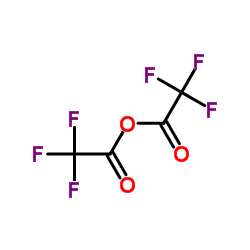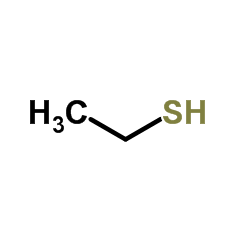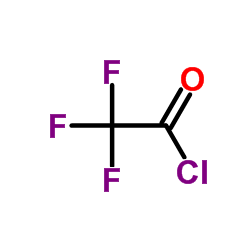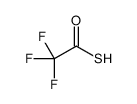Trifluoroacetonylmercaptoethanol

Trifluoroacetonylmercaptoethanol structure
|
Common Name | Trifluoroacetonylmercaptoethanol | ||
|---|---|---|---|---|
| CAS Number | 383-64-2 | Molecular Weight | 158.14200 | |
| Density | 1.234 g/mL at 25 °C(lit.) | Boiling Point | 90.5 °C(lit.) | |
| Molecular Formula | C4H5F3OS | Melting Point | N/A | |
| MSDS | Chinese USA | Flash Point | 39 °F | |
| Symbol |


GHS02, GHS07 |
Signal Word | Danger | |
| Name | s-ethyl trifluorothioacetate |
|---|---|
| Synonym | More Synonyms |
| Density | 1.234 g/mL at 25 °C(lit.) |
|---|---|
| Boiling Point | 90.5 °C(lit.) |
| Molecular Formula | C4H5F3OS |
| Molecular Weight | 158.14200 |
| Flash Point | 39 °F |
| Exact Mass | 158.00100 |
| PSA | 42.37000 |
| LogP | 1.82840 |
| Index of Refraction | n20/D 1.376(lit.) |
| Storage condition | Store at RT. |
Synonym: Section 2 - COMPOSITION, INFORMATION ON INGREDIENTS
Risk Phrases: 11 36/37/38 Section 3 - HAZARDS IDENTIFICATION EMERGENCY OVERVIEW
Highly flammable. Irritating to eyes, respiratory system and skin.The toxicological properties of this material have not been fully investigated. Potential Health Effects Eye: May cause eye irritation. The toxicological properties of this material have not been fully investigated. Skin: May cause skin irritation. The toxicological properties of this material have not been fully investigated. Ingestion: May cause gastrointestinal irritation with nausea, vomiting and diarrhea. The toxicological properties of this substance have not been fully investigated. Inhalation: May cause respiratory tract irritation. The toxicological properties of this substance have not been fully investigated. Vapors may cause dizziness or suffocation. Chronic: No information found. Section 4 - FIRST AID MEASURES Eyes: Flush eyes with plenty of water for at least 15 minutes, occasionally lifting the upper and lower eyelids. Get medical aid. Skin: Get medical aid. Flush skin with plenty of water for at least 15 minutes while removing contaminated clothing and shoes. Wash clothing before reuse. Ingestion: If victim is conscious and alert, give 2-4 cupfuls of milk or water. Never give anything by mouth to an unconscious person. Get medical aid immediately. Inhalation: Remove from exposure and move to fresh air immediately. If not breathing, give artificial respiration. If breathing is difficult, give oxygen. Get medical aid. Notes to Physician: Section 5 - FIRE FIGHTING MEASURES General Information: As in any fire, wear a self-contained breathing apparatus in pressure-demand, MSHA/NIOSH (approved or equivalent), and full protective gear. Vapors may form an explosive mixture with air. Vapors can travel to a source of ignition and flash back. During a fire, irritating and highly toxic gases may be generated by thermal decomposition or combustion. Use water spray to keep fire-exposed containers cool. Extremely flammable liquid and vapor. Containers may explode in the heat of a fire. Will be easily ignited by heat, sparks or flame. Extinguishing Media: For small fires, use dry chemical, carbon dioxide, water spray or alcohol-resistant foam. For large fires, use water spray, fog, or alcohol-resistant foam. Use water spray to cool fire-exposed containers. Water may be ineffective. Do NOT use straight streams of water. Section 6 - ACCIDENTAL RELEASE MEASURES General Information: Use proper personal protective equipment as indicated in Section 8. Spills/Leaks: Absorb spill with inert material (e.g. vermiculite, sand or earth), then place in suitable container. Clean up spills immediately, observing precautions in the Protective Equipment section. Remove all sources of ignition. Use a spark-proof tool. Provide ventilation. A vapor suppressing foam may be used to reduce vapors. Section 7 - HANDLING and STORAGE Handling: Wash thoroughly after handling. Use only in a well-ventilated area. Ground and bond containers when transferring material. Avoid contact with eyes, skin, and clothing. Empty containers retain product residue, (liquid and/or vapor), and can be dangerous. Keep container tightly closed. Keep away from heat, sparks and flame. Avoid ingestion and inhalation. Do not pressurize, cut, weld, braze, solder, drill, grind, or expose empty containers to heat, sparks or open flames. Storage: Keep away from heat, sparks, and flame. Keep away from sources of ignition. Store in a tightly closed container. Store in a cool, dry, well-ventilated area away from incompatible substances. Flammables-area. Section 8 - EXPOSURE CONTROLS, PERSONAL PROTECTION Engineering Controls: Use adequate general or local exhaust ventilation to keep airborne concentrations below the permissible exposure limits. Exposure Limits CAS# 383-64-2: United States OSHA: 2.5 mg/m3 TWA (as F) (listed under Fluorides Personal Protective Equipment Eyes: Wear appropriate protective eyeglasses or chemical safety goggles as described by OSHA's eye and face protection regulations in 29 CFR 1910.133 or European Standard EN166. Skin: Wear appropriate protective gloves to prevent skin exposure. Clothing: Wear appropriate protective clothing to prevent skin exposure. Respirators: Follow the OSHA respirator regulations found in 29 CFR 1910.134 or European Standard EN 149. Use a NIOSH/MSHA or European Standard EN 149 approved respirator if exposure limits are exceeded or if irritation or other symptoms are experienced. Section 9 - PHYSICAL AND CHEMICAL PROPERTIES Physical State: Liquid Color: colorless Odor: Not available. pH: Not available. Vapor Pressure: Not available. Viscosity: Not available. Boiling Point: 90.4 deg C @ 760.00mm Hg Freezing/Melting Point: Not available. Autoignition Temperature: Not available. Flash Point: 3 deg C ( 37.40 deg F) Explosion Limits, lower: Not available. Explosion Limits, upper: Not available. Decomposition Temperature: Solubility in water: Specific Gravity/Density: 1.2340g/cm3 Molecular Formula: C4H5F3OS Molecular Weight: 158.14 Section 10 - STABILITY AND REACTIVITY Chemical Stability: Stable under normal temperatures and pressures. Conditions to Avoid: Incompatible materials, ignition sources, dust generation, excess heat, strong oxidants. Incompatibilities with Other Materials: Strong bases, strong acids, strong reducing agents, strong oxidizing agents. Hazardous Decomposition Products: Carbon monoxide, irritating and toxic fumes and gases, carbon dioxide, hydrogen fluoride gas, hydrogen sulfide, sulfur oxides (SOx), including sulfur oxide and sulfur dioxide. Hazardous Polymerization: Has not been reported Section 11 - TOXICOLOGICAL INFORMATION RTECS#: CAS# 383-64-2 unlisted. LD50/LC50: Not available. Carcinogenicity: S-Ethyl Trifluorothioacetate - Not listed by ACGIH, IARC, or NTP. Section 12 - ECOLOGICAL INFORMATION Section 13 - DISPOSAL CONSIDERATIONS Dispose of in a manner consistent with federal, state, and local regulations. Section 14 - TRANSPORT INFORMATION IATA Shipping Name: FLAMMABLE LIQUID, N.O.S.* Hazard Class: 3 UN Number: 1993 Packing Group: II IMO Shipping Name: FLAMMABLE LIQUID, N.O.S. Hazard Class: 3.2 UN Number: 1993 Packing Group: II RID/ADR Shipping Name: FLAMMABLE LIQUID, N.O.S. Hazard Class: 3 UN Number: 1993 Packing group: II Section 15 - REGULATORY INFORMATION European/International Regulations European Labeling in Accordance with EC Directives Hazard Symbols: XI F Risk Phrases: R 11 Highly flammable. R 36/37/38 Irritating to eyes, respiratory system and skin. Safety Phrases: S 9 Keep container in a well-ventilated place. S 16 Keep away from sources of ignition - No smoking. S 28A After contact with skin, wash immediately with plenty of water. S 33 Take precautionary measures against static discharges. S 37 Wear suitable gloves. S 45 In case of accident or if you feel unwell, seek medical advice immediately (show the label where possible). WGK (Water Danger/Protection) CAS# 383-64-2: No information available. Canada CAS# 383-64-2 is listed on Canada's DSL List. CAS# 383-64-2 is not listed on Canada's Ingredient Disclosure List. US FEDERAL TSCA CAS# 383-64-2 is listed on the TSCA inventory. SECTION 16 - ADDITIONAL INFORMATION N/A |
| Symbol |


GHS02, GHS07 |
|---|---|
| Signal Word | Danger |
| Hazard Statements | H225-H315-H319-H335 |
| Precautionary Statements | P210-P261-P305 + P351 + P338 |
| Personal Protective Equipment | Eyeshields;Faceshields;full-face respirator (US);Gloves;multi-purpose combination respirator cartridge (US);type ABEK (EN14387) respirator filter |
| Hazard Codes | F: Flammable;Xi: Irritant; |
| Risk Phrases | R11;R36/37/38 |
| Safety Phrases | S16-S26-S36 |
| RIDADR | UN 3272 3/PG 2 |
| WGK Germany | 3 |
| Packaging Group | II |
| Hazard Class | 3.1 |
| HS Code | 2930909090 |
|
~% 
Trifluoroaceton... CAS#:383-64-2 |
| Literature: Bock,E. et al. Canadian Journal of Chemistry, 1974 , vol. 52, p. 3113 - 3118 Full Text Show Details Hauptschein et al. Journal of the American Chemical Society, 1952 , vol. 74, p. 4005,4007 |
|
~% 
Trifluoroaceton... CAS#:383-64-2 |
| Literature: Hauptschein et al. Journal of the American Chemical Society, 1952 , vol. 74, p. 4005,4007 |
|
~48% 
Trifluoroaceton... CAS#:383-64-2 |
| Literature: Weeks, P.; Gard, G. L. Journal of Fluorine Chemistry, 1971 , vol. 1, p. 295 - 307 |
| HS Code | 2930909090 |
|---|---|
| Summary | 2930909090. other organo-sulphur compounds. VAT:17.0%. Tax rebate rate:13.0%. . MFN tariff:6.5%. General tariff:30.0% |
|
Fluorinated proteins as potential 19F magnetic resonance imaging and spectroscopy agents.
Bioconjug. Chem. 5(3) , 257-61, (1994) Fluorinated proteins have been synthesized and characterized as potential in vivo 19F magnetic resonance imaging (MRI) and spectroscopy (MRS) agents. Proteins labeled with fluorine include bovine seru... |
|
|
The primary structure of mitochondrial aspartate aminotransferase from pig heart: peptides obtained by cleavage at basic residues.
Ital. J. Biochem. 28(6) , 441-55, (1979) Results obtained as part of a study of the primary structure of mitochondrial aspartate aminotransferase from pig heart are described. In particular, the S-aminoethylated protein was digested with try... |
|
|
Specific cleavage of amino side chains of serine and threonine in peptides and proteins with S-ethyltrifluorothioacetate vapor.
Eur. J. Biochem. 255(1) , 162-71, (1998) A vapor of S-ethyltrifluorothioacetate was found to specifically cleave the amino side of serine and threonine peptide bonds. The cleavage reactions were carried out at 50 degrees C for 6 h-24 h or at... |
| Trifluorothioacetic Acid S-Ethyl Ester |
| S-ethyl 2,2,2-trifluoroethanethioate |
| EINECS 206-852-1 |
| MFCD00000421 |
| S-Ethyl Trifluorothioacetate [Trifluoroacetylating Agent |




